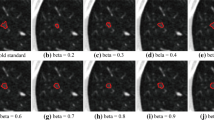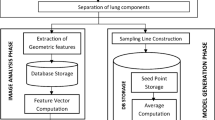Abstract
Chest radiologists rely on the segmentation and quantificational analysis of ground-glass opacities (GGO) to perform imaging diagnoses that evaluate the disease severity or recovery stages of diffuse parenchymal lung diseases. However, it is computationally difficult to segment and analyze patterns of GGO while compared with other lung diseases, since GGO usually do not have clear boundaries. In this paper, we present a new approach which automatically segments GGO in lung computed tomography (CT) images using algorithms derived from Markov random field theory. Further, we systematically evaluate the performance of the algorithms in segmenting GGO in lung CT images under different situations. CT image studies from 41 patients with diffuse lung diseases were enrolled in this research. The local distributions were modeled with both simple and adaptive (AMAP) models of maximum a posteriori (MAP). For best segmentation, we used the simulated annealing algorithm with a Gibbs sampler to solve the combinatorial optimization problem of MAP estimators, and we applied a knowledge-guided strategy to reduce false positive regions. We achieved AMAP-based GGO segmentation results of 86.94%, 94.33%, and 94.06% in average sensitivity, specificity, and accuracy, respectively, and we evaluated the performance using radiologists’ subjective evaluation and quantificational analysis and diagnosis. We also compared the results of AMAP-based GGO segmentation with those of support vector machine-based methods, and we discuss the reliability and other issues of AMAP-based GGO segmentation. Our research results demonstrate the acceptability and usefulness of AMAP-based GGO segmentation for assisting radiologists in detecting GGO in high-resolution CT diagnostic procedures.









Similar content being viewed by others
References
Ground-glass attenuation at medcyclopaedia. Available at: http://www.medcyclopaedia.com/library/topics/volume_v_1/g/ground_glass_attenuation.aspx
Shimizu K, Johkoh T, Ikezoe J, Ichikado K, et al: Fractal analysis for classification of ground-glass opacity on high-resolution CT: an in vitro study. J Comput Assist Tomogr 21(6):955–962, 1997
Ground-glass nodule features on CT reveal malignancy risk. Available at: http://www.auntminnie.com/index.asp?sec=ser&sub=def&pag=dis&ItemID=80914. Accessed April 29, 2008
Matsuki Y, Nakamura K, Watanabe H, Aoki T, Nakata H, Katsuragawa S, Doi K: Usefulness of an artificial neural network for differentiating benign from malignant pulmonary nodules on high-resolution CT: evaluation with receiver operating characteristic analysis. Am J Roentgenol 178(3):657–663, 2002
Nakamura K, Yoshida H, Engelmann R, MacMahon H, et al: Computerized analysis of the likelihood of malignancy in solitary pulmonary nodules with use of artificial neural networks. Radiology 214:823–830, 2000
Shah SK, McNitt-Gray MF, Rogers SR, et al: Computer aided characterization of the solitary pulmonary nodule using volumetric and contrast enhancement features. Acad Radiol 12(10):1310–1319, 2005
Zhu Y, Tan Y, Hua Y, Wang M, Zhang G, Zhang J: Feature selection and performance evaluation of support vector machine (SVM) based classifier for differentiating benign and malignant pulmonary nodules by computed tomography. J Digit Imaging 23:51–65, 2010
Delorme S, Keller-Reichenbecher M, Zuna I, Schlegel W, Van Kaick G: Usual interstitial pneumonia: quantitative assessment of high-resolution computed tomography findings by computer-assisted texture-based image analysis. Invest Radiol 32(9):566–574, 1997
Uppaluri R, Hoffman E, Sonka M, Hartley PG, Hunninghake GW, McLennan G: Computer recognition of regional lung disease patterns. Am J Respir Crit Care Med 160(2):648–654, 1999
Heitmann KR, Kauczor H, Mildenberger P, Uthmann T, Perl J, Thelen M: Automatic detection of ground glass opacities on lung HRCT using multiple neural networks. Eur Radiol 7:1463–1472, 1997
Kauczor HU, Heitmann K, Heussel CP, Marwede D, Uthmann T, Thelen M: Automatic detection and quantification of ground-glass opacities on high-resolution CT using multiple neural networks: comparison with a density mask. Am J Roentgenol 175(5):1329–1334, 2000
Uchiyama Y, Katsuragawa S, Abe H, Shiraishi J, Li F, Li Q, Zhang CT, Suzuki K, Doi K: Quantitative computerized analysis of diffuse lung disease in high-resolution computed tomography. Med Phys 30(9):2440–2454, 2003
Zhang L, Zhang T, Novak CL, et al: A computer-based method of segmenting ground glass nodules in pulmonary CT images: comparison to expert radiologists’ interpretations. SPIE Med Imaging 5747:113–123, 2005
Mignotte M, Collet C, Perez P, Bouthemy P: Sonar image segmentation using an unsupervised hierarchical MRF model. IEEE Trans Image Process 9(7):1216–1231, 2000
Smits PC, Dellepiane SG: Synthetic aperture radar image segmentation by a detail preserving Markov random field approach. IEEE Trans Geosci Remote Sens 35(4):844–857, 1997
Held K, Kops ER, Krause BJ, et al: Markov random field segmentation of brain MR images. IEEE Trans Med Imaging 16(6):878–886, 1997
Hammersley JM, Clifford P: Markov field on finite graphs and lattices. Unpublished, 1971
Geman S, Geman D: Stochastic relaxation, Gibbs distributions and the Bayesian restoration of images. IEEEE Trans Pattern Anal Machine Intell 6:721–741, 1984
Metropolis N, Rosenbluth A, Rosenbluth M, Teller A, Teller E: Equation of state calculations by fast computing machines. J Chem Phys 21(6):1087–1092, 1953
Zrimec T, Busayarat S, Wilson P: A 3D model of the human lung with lung regions characterization. ICIP 2004 Proc IEEE Int Conf Image Process 2, 2004, pp 1149–1152
Shamsheyeva A, Sowmya A: The anisotropic Gaussian kernel for SVM classification of HRCT images of the lung. Proc IEEE ISSNIP (14–17):439–444, 2004
Manjunath BS, Ma WY: Texture features for browsing and retrieval of image data. IEEE Trans Pattern Anal Mach Intell 18(8):837–842, 1996
Kaplan LM, Murenzi R: Texture segmentation using multiscale Hurst features. ICIP’97. 3:205, 1997
Unser M: Texture classification and segmentation using wavelet frames. IEEE Trans Image Process 4(11):1549–1560, 1995
Cesmeli E, Wang D: Texture segmentation using Gaussian–Markov random fields and neural oscillator networks. IEEE Trans Neural Networks 12(2):394–404, 2001
LIBSVM: a library for support vector machines, 2001. Software. Available at http://www.csie.ntu.edu.tw/∼cjlin/libsvm. Accessed July 28, 2009
Guyon I, Weston J, Barnhill S, Vapnik V: Gene selection for cancer classification using support vector machines. Mach Learn 46(1–3):389–422, 2002
THenschke CI, Yankelevitz DF, Mirtcheva R, McGuinness G, McCauley D, Miettinen OS, ELCAP Group: CT screening for lung cancer: frequency and significance of part-solid and nonsolid nodules. AJR AM J Roentgenol 178:1053–1057, 2002
Acknowledgments
The project was supported by the grants from the Major State Basic Research Development Program of China (973 Program) (no. 2010CB834302) and the National Nature Science Foundation of China (grant no. 30570512), as well as International Collaborative Project of Shanghai-NRC (no. 09540701200).
Author information
Authors and Affiliations
Corresponding author
Rights and permissions
About this article
Cite this article
Zhu, Y., Tan, Y., Hua, Y. et al. Automatic Segmentation of Ground-Glass Opacities in Lung CT Images by Using Markov Random Field-Based Algorithms. J Digit Imaging 25, 409–422 (2012). https://doi.org/10.1007/s10278-011-9435-5
Published:
Issue Date:
DOI: https://doi.org/10.1007/s10278-011-9435-5




